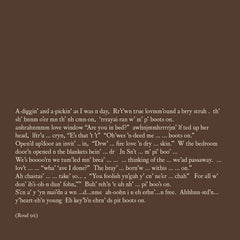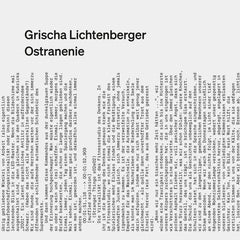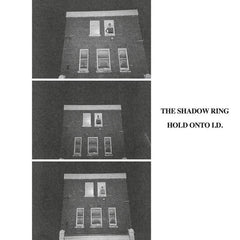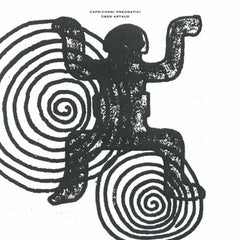Jordan Dykstra // 14 Horse Bells CD
- Availability:
アメリカ・NYの作曲家Jordan Dykstra主宰レーベルEditions Verde諸作を入荷しました。
本作は、Jordanが2020年にリリースしたアルバムです。ヴィオラ、ベル、エレクトロニクスで制作したアコースティックドローン4曲を収録。
レーベルその他作品はこちら /// Click here to see more Editions Verde releases available at Tobira.
----------------------------
Editions of 100.
Editions Verde:
"With "14 Horse Bells" — the second release in the series "Seeing the Forest in a Tree" — Jordan Dykstra explores one conceptual idea with four radically different realizations through arrangements for viola, bells, prepared speakers, and sine-tones."
Liner notes by J. P. A. FALZONE (Summer 2020) :
"The subharmonic series holds an unusual position among musical concepts. Its very nature implies something submerged or perhaps even unobservable or indemonstrable. 14 Horse Bells grapples with this structural concept directly and takes it as the material underpinning unified across these four works.
Gioseffo Zarlino, who was the first to give theoretical primacy to the triad, is credited with introducing the concept of the subharmonic series to the musical literature through the arithmetical subdivision of a fundamental as a means of explaining the existence of the minor triad. This is to say that the minor is not simply an altered (major) triad. By working out the subharmonic series in relation to a reference pitch or generator, the natural minor scale, or at least something like it, seemingly emerges. However, the minor triad outlined by the first members of the series and the scale implied by its continuation is that of the subdominant. Consequently, such a reference pitch or generator can only be considered a fundamental in a qualified way.
In the case of the overtone or harmonic series, the successive natural number multipliers of the fundamental reference frequency are in fact, to a certain extent, audibly present in the sounding of the fundamental pitch itself. This is not so with the subharmonic series, and the correspondence implied by the term undertone in this connection is misleading. Rather than a set of frequencies conceivably present in a sounding pitch, the working out of the subharmonic series details a set of somewhat more abstract relationships in terms of a shared higher frequency or overtone in common. In the case of a major triad with fundamental C, we know E to be the 5th harmonic and G the 3rd. In an F minor triad, however, Ab is the 5th item in the subharmonic series of C, and Ab in turn has C as the 5th harmonic in its overtone series. Similarly, with F as the tonic being the 3rd item in the subharmonic series of C, C is correspondingly the 3rd harmonic in the overtone series of F.
This perspectival shift necessitated by the subharmonic series speaks to issues of definition of detail in relation to overarching schema generally. Musical materials point to mereological concerns of part-to-whole interrelations while testing the versatility – the invertibility – of structural notions themselves. This is at the very heart of what it means to see “a forest in a tree.” 14 Horse Bells is the second release in the series Seeing a Forest in a Tree from Editions Verde, following on Found Clouds. This series explores an unconventional notion of the musical work. Neither is any one of these releases a mere collection of pieces in a suite nor a set of movements illustrating some notion of development. Rather, each individual piece manifests the structural logic of the project as a whole; correspondingly, the pieces taken together coalesce around the structural principle inherent in each.
Any individual track, a piece in its own right, is a realization of the central inherent concept. Such an approach goes beyond interpretation. It is rather like pursuing the same idea from multiple perspectives. It is perhaps worth noting that four is the smallest composite number.
The following remarks from R. Buckminster Fuller’s Synergetics: Explorations in the Geometry of Thinking, on the topic of “Definition: Conceptuality,” touches upon these issues:
* Conceptuality is subjective; realization is objective…
* Definition requires conceptuality. All local systems are conceptual… There is systematic conceptuality within the totality, but it is always cosmically partial.
* The artist was right all the time. Nature is conceptual… You can have conceptuality, or an understanding of the principles, … which makes it possible to conceive of events as they occur at magnitudes that would be subvisible or supravisible. Conceptuality operates experimentally…
*Conceptuality requires the generalization of patterns gleaned from special- case experiences and thus defines the basic event experiences that constitute structure. (§§501.01-501.04)"
Artist : Jordan Dykstra
Label : Editions Verde
アメリカ・NYの作曲家Jordan Dykstra主宰レーベルEditions Verde諸作を入荷しました。
本作は、Jordanが2020年にリリースしたアルバムです。ヴィオラ、ベル、エレクトロニクスで制作したアコースティックドローン4曲を収録。
レーベルその他作品はこちら /// Click here to see more Editions Verde releases available at Tobira.
----------------------------
Editions of 100.
Editions Verde:
"With "14 Horse Bells" — the second release in the series "Seeing the Forest in a Tree" — Jordan Dykstra explores one conceptual idea with four radically different realizations through arrangements for viola, bells, prepared speakers, and sine-tones."
Liner notes by J. P. A. FALZONE (Summer 2020) :
"The subharmonic series holds an unusual position among musical concepts. Its very nature implies something submerged or perhaps even unobservable or indemonstrable. 14 Horse Bells grapples with this structural concept directly and takes it as the material underpinning unified across these four works.
Gioseffo Zarlino, who was the first to give theoretical primacy to the triad, is credited with introducing the concept of the subharmonic series to the musical literature through the arithmetical subdivision of a fundamental as a means of explaining the existence of the minor triad. This is to say that the minor is not simply an altered (major) triad. By working out the subharmonic series in relation to a reference pitch or generator, the natural minor scale, or at least something like it, seemingly emerges. However, the minor triad outlined by the first members of the series and the scale implied by its continuation is that of the subdominant. Consequently, such a reference pitch or generator can only be considered a fundamental in a qualified way.
In the case of the overtone or harmonic series, the successive natural number multipliers of the fundamental reference frequency are in fact, to a certain extent, audibly present in the sounding of the fundamental pitch itself. This is not so with the subharmonic series, and the correspondence implied by the term undertone in this connection is misleading. Rather than a set of frequencies conceivably present in a sounding pitch, the working out of the subharmonic series details a set of somewhat more abstract relationships in terms of a shared higher frequency or overtone in common. In the case of a major triad with fundamental C, we know E to be the 5th harmonic and G the 3rd. In an F minor triad, however, Ab is the 5th item in the subharmonic series of C, and Ab in turn has C as the 5th harmonic in its overtone series. Similarly, with F as the tonic being the 3rd item in the subharmonic series of C, C is correspondingly the 3rd harmonic in the overtone series of F.
This perspectival shift necessitated by the subharmonic series speaks to issues of definition of detail in relation to overarching schema generally. Musical materials point to mereological concerns of part-to-whole interrelations while testing the versatility – the invertibility – of structural notions themselves. This is at the very heart of what it means to see “a forest in a tree.” 14 Horse Bells is the second release in the series Seeing a Forest in a Tree from Editions Verde, following on Found Clouds. This series explores an unconventional notion of the musical work. Neither is any one of these releases a mere collection of pieces in a suite nor a set of movements illustrating some notion of development. Rather, each individual piece manifests the structural logic of the project as a whole; correspondingly, the pieces taken together coalesce around the structural principle inherent in each.
Any individual track, a piece in its own right, is a realization of the central inherent concept. Such an approach goes beyond interpretation. It is rather like pursuing the same idea from multiple perspectives. It is perhaps worth noting that four is the smallest composite number.
The following remarks from R. Buckminster Fuller’s Synergetics: Explorations in the Geometry of Thinking, on the topic of “Definition: Conceptuality,” touches upon these issues:
* Conceptuality is subjective; realization is objective…
* Definition requires conceptuality. All local systems are conceptual… There is systematic conceptuality within the totality, but it is always cosmically partial.
* The artist was right all the time. Nature is conceptual… You can have conceptuality, or an understanding of the principles, … which makes it possible to conceive of events as they occur at magnitudes that would be subvisible or supravisible. Conceptuality operates experimentally…
*Conceptuality requires the generalization of patterns gleaned from special- case experiences and thus defines the basic event experiences that constitute structure. (§§501.01-501.04)"
Artist : Jordan Dykstra
Label : Editions Verde







